 |
April 2011
|
April 2011 // Volume 49 // Number 2 // Feature // v49-2a8
Stormwater Monitoring and Resident Behavior in a Semi-Arid Region
Abstract
Stormwater from a small municipality in Utah was monitored for flow and phosphorus. A survey was also administered to ascertain potential behavioral impacts on stormwater. The majority (53.7%) of stormwater measured was non-storm related. It is suspected that summer irrigation was adding to baseflow. Concentrations of phosphorus were below national means, but were high enough to lead to excessive algal growth. Survey results showed that most residents (92.3%) fertilize their lawn, although very few (1.7%) use a soil test to determine if fertilization is necessary. The study highlights the need for monitoring, surveying and collaboration to address current stormwater issues.
Introduction
The negative effects of stormwater runoff from urban areas have been demonstrated (US EPA, 2002). Humid regions have often been the focus of stormwater research and education; however, receiving waters near urban areas in the semi-arid western United States also have negative impacts from stormwater runoff. Management of stormwater in these regions is confounded by irrigation withdrawals and return flows, as well as sewage treatment plant discharges in some locations (Reginato & Piechota, 2004).
Education has long been suggested as a means to foster adoption of techniques to reduce nonpoint source pollution (US EPA, 1993). To meet the requirements of the Phase II Municipal Separate Storm Sewer System (MS4) permit, many smaller municipalities are now required to provide community education about stormwater issues (US EPA, 2005). Municipalities often do not have experience providing outreach, and are not equipped to deal with this extra responsibility.
This is an ideal opportunity for Extension to partner with municipalities and help provide this service; these types of partnerships have been successfully implemented in many locations (e.g., Axness, 2007). Programs to educate land-use decision makers in local governments have been developed in Nevada, Arizona and Colorado as part of the National Nonpoint Education for Municipal Officials (NEMO) program <http://nemonet.uconn.edu/>. Stormwater education campaigns have also been developed to educate citizens about how to reduce their potential contribution to stormwater pollution; the Salt Lake County Stormwater Coalition <http://www.stormwatercoalition.org/> is one such effort in Utah.
Watershed-based educational efforts have been described (Brenner et al., 1998; Hottenroth, Harper, & Turner, 1999; Swann, 2000; US EPA, 1992). Best Management Practices (BMPs) are often the focus of the educational campaigns geared towards citizens (Dietz, Clausen, Warner, & Filchak, 2002). Recommendations for residential homes often center around 1) reducing bacterial contamination by picking up pet waste, 2) reducing nutrient loading (specifically phosphorus) by not washing cars on impervious surfaces, and 3) taking soil tests to determine how much lawn fertilizer is needed, and applying fertilizer properly so it doesn't spread on impervious surfaces. Some educational campaigns also provide information on how to reduce the effective impervious area of a site (Booth & Jackson, 1997), or the area directly connected to the stormwater system, by directing gutter downspouts to lawn, rain garden areas, rain barrels, or cisterns. Rainwater harvesting is being recommended in the arid and semi-arid west to reduce stormwater pollution. If performed on a large scale this can be an effective tool to reduce stormwater impacts.
However, other approaches are needed to reduce the large stormwater contributions from the roads, parking lots and driveways that comprise a large percentage of impervious surface in a watershed. In addition, western water law has made it illegal for individuals to harvest water from their own roof; fortunately this is changing in many states, and in Utah a homeowner can now legally harvest up to 2,500 gallons of water from their own roof.
Intensive training sessions (e.g., workshops, consultations, and guidebooks) and media campaigns (e.g., radio, TV, direct mailing, and signs) have generally been found to be the most effective methods for instigating behavior change (Swann, 2000). Other commonly used techniques, such as newsletters, demonstration projects, and use of the Internet, have not been as effective in bringing about behavior change. Despite the findings reported by Swann (2000), other research has shown that even intensive education efforts may not bring about the desired behavior changes (or ultimately water quality improvements). For example, in Australia, intensive training sessions resulted in no significant changes in the knowledge or attitudes of the public, and only modest reductions in litter loads (Taylor, Curnow, Fletcher, & Lewis, 2007). Similar results were found in Connecticut, where modest behavior changes and only slight improvements in water quality were reported (Dietz, Clausen, & Filchak, 2004; Dietz et al., 2002).
Kaysville, Utah is a small municipality with approximately 20,000 residents, in a semi-arid region in northern Utah. The watershed is mostly developed (Table 1) and is served by sanitary sewers and a separate stormwater system. The impervious cover of the watershed was estimated to be 38.2%.
Table 1.
Land Cover Classifications and Percentages in Study Watershed, Kaysville, Utah
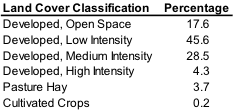
Average (30-year) annual precipitation is 58.9 cm (NCDC, 2009). A stormwater outfall pipe from a 271.7 ha watershed enters a series of ponds at the Utah Botanical Center (UBC) <http://utahbotanicalcenter.org/> in Kaysville (Figure 1). Algae blooms and low dissolved oxygen have become commonplace in the ponds at the UBC. These conditions negatively affect the health of the fish in the ponds, which the local community uses for recreational purposes. The outlet of the ponds leads back into the stormwater system, which ultimately leads to the Great Salt Lake.
The objectives of the research project reported here were the following:
- To provide background monitoring data for flow, and total phosphorus (TP) loads entering the ponds at the UBC.
- To administer a survey to residents of the watershed to assess their current attitudes and practices related to stormwater.
- To evaluate the effect of a watershed-wide educational effort on the behaviors of watershed residents, and on the quantity and quality of stormwater entering the ponds.
Initially, the intent was to use the results from objectives 1 and 2 as background data for objective 3. Monitoring would have continued after the education effort to determine what changes occurred as a result of the effort. However, additional funding for this second phase of the project was not obtained; therefore, the findings from objectives 1 and 2 are presented in this article.
Figure 1.
Watershed of Ponds (Heavy Black
Line) at Utah Botanical Center, Kaysville, Utah. Star Indicates
Location of Monitoring Site, Triangle Represents Location of Rain
Gauge
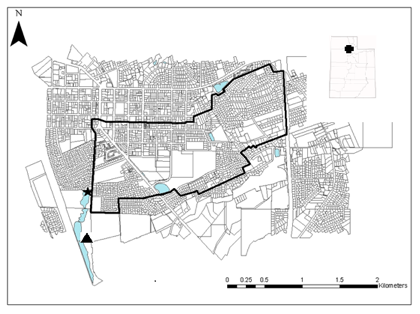
Methods
Water Quality Monitoring
An existing stormwater outfall at the pond entrance had a concrete sediment/trash trap and a 90o V-notch weir. Stormwater quantity was measured using a pressure transducer (installed in a stilling well) connected to a Campbell Scientific CR850 datalogger. Flow was calculated by the datalogger using a standard formula for the weir, and accumulated flow was recorded every 10 minutes. Water sampling was initiated after a fixed volume of flow had passed the weir, via an ISCO GLS compact sampler. Ice packs were installed in the sampler to keep samples cool. Samples were then transported in a cooler approximately 1 hour, frozen, and shipped with ice packs to a laboratory for total phosphorus (TP) analysis. Flow measurements and grab sampling were also performed at the pond outlet, but these data are not presented in this paper.
Precipitation was measured 0.75 km from the monitoring site using an unheated tipping bucket rain gauge. Precipitation totals were recorded for 30-minute intervals using a Campbell Scientific CR-10 datalogger.
Survey
A survey was mailed to every residence in the watershed in Kaysville (1,200 homes). Addresses for all homes in the watershed were obtained from the city of Kaysville. The mailing contained a cover letter explaining the project, a survey, and a postage-paid return envelope. With the hope of increasing the response rate, an incentive was offered to those who completed the survey; they would be entered into a drawing for one of three $100 gift certificates to a local business of their choice.
Survey questions focused mainly on outdoor household management practices. Specific questions concerning pet waste and oil disposal, fertilization applications, and car washing practices were included in the survey to get an idea of the types of pollutants that may potentially be released into the stormwater system. Questions were also included to address the respondents' perception of existing water quality in their surrounding area, the value they place on the water resources in their area, whether or not they believe that their actions affect the water quality in the area, and whether they recall receiving educational materials about stormwater.
Results
Water Quantity
Water quantity monitoring began on June 20, 2008 at the pond inlet. High flow rates were observed during storm events, the largest of which was 22.4 mm of rainfall in a 24-hour period. It should be noted that during extremely heavy flow such as that which occurred during the 22.4 mm storm, some flow may have bypassed the monitoring station just upstream due to water backing up in the sediment trap. There was only evidence of this occurring one time during the period of study (one year), and the contribution to the long-term flow calculations is likely very small.
Some interesting trends in water quantity can be seen. Non-storm flow was found to increase throughout the summer months, peaking in September, with a decline noted through the fall and into winter (Figure 2). It is likely that residential and/or commercial irrigation was overflowing into the stormwater system and causing this flow. The engineer from Kaysville (Andy Thompson, personal communication, 2008) also noted that there are substantial tile drains beneath some of the large fields at the schools in the watershed. These drains are tied in to the stormwater system and were installed to drain shallow groundwater away from the fields.
Figure 2.
Inlet Flow and Precipitation for
Utah Botanical Center Research Site
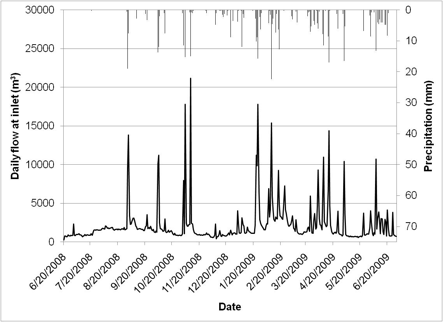
They would also likely channel excess irrigation flows to the system. The fluctuations noted at the pond inlet seem to indicate that a daily irrigation schedule may be contributing substantial volumes to the pond (Figure 3). This diurnal pattern was noted from June through September and ceased in early October. Interestingly, water temperature at the inlet mirrored the diurnal pattern, with slightly higher temperatures (about 1° C higher) associated with higher flow rates (Figure 3). This relationship indicates likely surface water/irrigation influence, as groundwater flows would likely have a more stable temperature. The time of peak flow was always between 2:00 a.m. and 4:00 a.m., and time of lowest flow was consistently in the afternoon, between 1:00 p.m. and 5:00 p.m. The variation was substantial; low flows in July were around 7.3 L/s, whereas high flows were around 16.7 L/s (Figure 3).
Figure 3.
Flow and Water Temperature at Pond Inlet, 7/18/08-7/20/08, Utah Botanical Center

Numerous precipitation events were noted from September 2008 through June 2009, ranging from 3.3 mm to 22.4 mm. The flow due to these storms was estimated through graphical base flow separation (Dingman, 1994). In several instances, precipitation amounts were pooled, as separating stormflow values for each would not be possible due to the short duration of time between measurable precipitation events. The associated flow values were also pooled. It also should be noted that snowfall and snowmelt complicate the precipitation/runoff relationship. The rain gauge used at the site is not a heated gauge, so there may be some error in measurement, or at least a delay in the time of measurement. Also, snowmelt takes place over several days.
Despite the significant increases in stormflow associated with precipitation events, non-storm flow was found to be 53.7% of the total volume measured at the pond inlet, and flow due to precipitation events was 46.3% of the total. This finding has significant implications for the possible effectiveness of education and structural changes designed to reduce stormwater volumes entering the ponds, and will be discussed further.
Water Quality
TP concentrations varied somewhat through the year, but no seasonal pattern was noted (Figure 4). The mean TP concentration of 0.092 ± 0.049 mg L-1 found at the pond inlet (n=51) was lower than the median concentration of 0.259 mg L-1 reported for urban areas across the United States (Smullen, Shallcross, & Cave, 1999), although it is still high enough to cause excessive algal growth in the ponds. TP export from the watershed was 0.30 kg ha-1 yr-1. This is less than TP export of 1.48 kg ha-1 yr-1 noted from medium density urban areas around the United States (USEPA, 1983).
Figure 4.
TP Concentrations at Pond Inlet, Utah Botanical Center
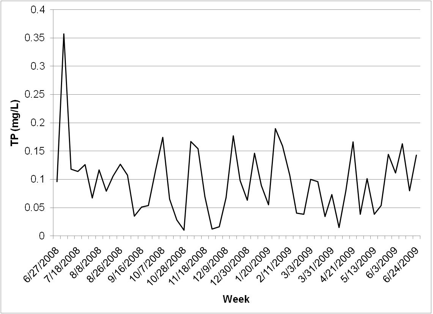
Survey
Of the 1,200 surveys sent out to residents in the watershed, 264 were returned, resulting in a 22% response rate. Assuming a confidence level of 95%, the resulting error (+/-) is 5.3% (http://www.surveysystem.com/sscalc.htm). Survey respondents were largely Caucasian (97.3%), well educated (87.8% having some college or higher degrees completed), and middle aged (60.5% between 35 and 64).
When asked about their opinion on the quality of streams, rivers and lakes in their area, respondents felt that they were generally of good quality (mean response=3.1 on a scale of 1 to 5). However, the majority (65.4%) reported that they did not use the water resources within 10 minutes of their home for recreation (Table 2).
Table 2.
Selected Survey Questions and Responses

The majority of residents also reported that they had not received any educational materials about stormwater in their city, despite the fact that Kaysville falls under EPA Phase II stormwater regulations and is required to provide some public education. Chi-square analysis was performed for all surveyed behaviors that would have an impact on stormwater (e.g., how their lawn is managed, how pet waste is managed, where they wash their car), according to whether the person reported receiving educational materials. No significant differences were found for any of the surveyed behaviors, demonstrating that people who received information were not acting any differently than those who did not. This finding is consistent with behavioral research, where the correlation between knowledge of an environmental topic and an associated behavior is weak at best (Hungerford & Volk, 1990; Ramsey & Rickson, 1976).
It is a common educational practice to provide information to someone and assume that they will change their behavior after learning about the topic. In Connecticut, even high-intensity educational efforts resulted in fairly low levels of engagement in pro-environmental behaviors (Dietz et al., 2004). Engagement in these types of pro-environmental behaviors is increasingly seen to be a result of complex interactions between internal factors such as knowledge, desire to act, emotional responses, and external factors such as economic constraints, convenience of the activity, and social pressures (Barr, 2007; Edgerton, McKechnie, & Dunleavy, 2008; Hines, Hungerford, & Tomera, 1986; Kollmuss & Agyeman, 2002; Saphores, Nixon, Ogunseitan, & Shapiro, 2006).
When asked to identify which items are sources of water pollution, respondents agreed that their yards were sources of pollution, yet these sources were rated lower than others such as farm field runoff and construction site runoff (Figure 5). Trash from people and manufacturing plants were reported as the largest sources of water pollution (Figure 5), despite the fact that in reality these sources contribute very little to local water quality problems. This response is likely due to the visibility of trash in the landscape; people assume that trash causes poor water quality. This response is consistent with that of the overall population who believe certain environmental myths to be fact (Coyle, 2005).
Figure 5.
Mean Responses Identifying Sources of Water Pollution. Scale is 1 (Strongly Disagree) to 5
(Strongly Agree)
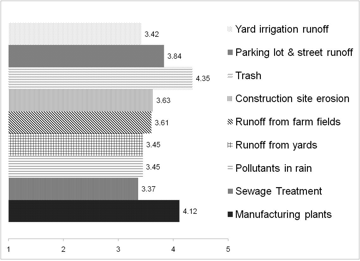
The vast majority of residents reported having a lawn that they mow (98.9%) and fertilize (92.3%), although a lower percentage reported using pesticides on their lawn (Table 1). Most residents take care of their own yard (92.3%), although 34.9% reported using a professional service for fertilization. Very few (1.7%) residents reported using a soil test to determine if fertilization was necessary. Fertilization was reported in all seasons of the year, although spring, summer, and fall applications were the most frequent (Table 3).
Lawn fertilization is another potential source of phosphorus loading to the stormwater system. Most residents are fertilizing, and only a tiny fraction of residents actually use a soil test to see if fertilization is needed. Typical application methods result in excess fertilizer being spread on impervious surfaces adjacent to lawn areas. Rainfall would likely wash accumulated fertilizer into the stormwater system. Fertilizer would also be washed off impervious surfaces with the excess irrigation that was suspected to be entering the stormwater system during the summer months.
Table 3.
Frequency of Fertilization Applications by Season

Most residents wash their car infrequently, if at all, at their home (Figure 6). Of those who do, the majority (80.4%) reported washing their car in their driveway, and a smaller percentage (18.9%) washed the car on their lawn. The impact of car washing in the watershed on water quality is unknown. However, given the fact that most soaps are phosphate free, it is not likely that car washing would be a large contribution of phosphorus to the stormwater system. Some respondents (24.1%) indicated that they changed their own oil in their vehicle, and of those who did, 95.5% reported recycling that oil at a designated facility.
Figure 6.
Frequency of Home Car Washes
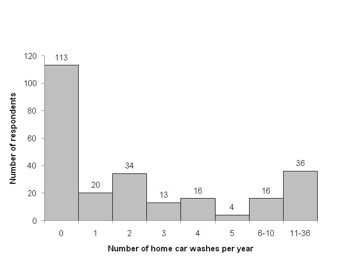
Most residents (95%) reported having gutters with downspouts, and the majority of those with gutters (90.7%) reported that they drain to lawn or garden areas, although 18.5% and 14.1% of residents reported that at least one gutter drained to a sidewalk/driveway, or a pipe in the ground, respectively. The contribution of roof runoff from houses is expected to be low, considering that the majority of respondents indicated that their downspouts drain to lawn or garden areas; however, disconnecting those downspouts directly connected to the stormwater system would provide some reduction in the stormwater load. Roof runoff could be directed to rain barrels, to existing lawn/garden areas, or to rain gardens, where appropriate.
Kaysville has not executed an independent stormwater education effort to comply with their MS4 requirements, but they may have contacted the Salt Lake County Stormwater Coalition to assist in this effort. It is not clear what type of educational materials have been distributed to residents of the city; however, it is clear that the residents do not have much recall of what was actually done. The survey reported here is the first of its kind to be administered in the city to assess behaviors related to stormwater, and the results highlight the need for further educational efforts in regards to the relationship between homeowner actions and stormwater quality.
Conclusions
A substantial portion (53.7%) of the inflow to the ponds at the UBC in Kaysville, Utah was non-storm related. The watershed contains several large athletic fields that had tile drains installed to drain shallow groundwater. These areas, along with shallow groundwater intrusion into the stormwater system, provide baseflow at the stormwater outfall to the ponds on the UBC property. This baseflow was highest during the summer months, suggesting that irrigation was contributing to baseflow during this time. The remaining 46.3% of pond inflow that was storm related was mostly due to the large areas of impervious surfaces present in the watershed. The areas with the largest amount of paved surfaces in the watershed were at schools and churches. An evaluation of potential retrofit sites to install bioretention at these locations has been submitted to Kaysville, although the potential reductions in flow from these structural changes would only be about 6% of the annual flow entering the ponds.
The mean concentration of TP entering the ponds was 0.092 mg L-1. Although this was lower than national means for developed areas, it is still high enough to lead to excess algal growth in the ponds.
Survey results indicated that only 14% of residents acknowledged receiving any educational materials about stormwater, and those who had did not manage their landscape or impervious surfaces any differently than those who had not. The city of Kaysville does not currently have an independent stormwater educational campaign, and information could not be obtained on what the previous educational effort from the Salt Lake Stormwater Coalition involved. This lack of knowledge as to what has been done in the city is indicative of the level of effort that has been put into a stormwater education program.
Behavioral changes to reduce flow volumes and TP concentrations such as fertilizing based on a soil test and proper fertilization techniques may result in improved water quality at the UBC ponds. However, TP concentrations in dry weather flow were also high. It is possible that misapplication of fertilizer combined with overspray of irrigation water on impervious surfaces was the source of TP in dry weather flow. Gutter downspout disconnections may have some benefit and should not be discouraged, but in this particular watershed, the impact of disconnecting a small number of downspouts would be minimal.
These findings indicate that. although broad information about water, watersheds, and stormwater is useful, it is perhaps better to target a small number of target behaviors that will likely result in the largest changes in the stormwater quantity and quality. For the study reported here, the target behaviors would be proper fertilization techniques (including soil testing to determine if fertilization is necessary) and proper irrigation techniques. One such effort targeted only the timing of fertilizer application in the Chesapeake Bay watershed, and changes in behavior were reported (CBSMI, 2005). For other watersheds, the targeted behaviors might be slightly different. For example, an urban watershed with mainly wet weather flows and a high number of directly connected roofs would want to target downspout disconnections to have the greatest impact.
The implication for Extension here is the importance of understanding the watershed and the actions of its residents before initiating an educational effort. To determine the target behaviors for a particular watershed, the water quantity/quality regime and the behavior of residents should be investigated. Although there is a cost involved, monitoring over the course of four seasons will provide valuable data to help target educational efforts to behaviors or structural changes that will have the most potential for actual water quality improvements. This is not to say that information has no value for a community; the authors feel that knowledge of environmental topics should increase across the population. However, when a fixed amount of funding is available, it would be more efficient to use funds for efforts that will likely lead to a change, rather than supporting efforts that will have questionable impact.
These findings also underscore the importance of planning for new developments; education efforts such as the NEMO program that are targeted at the municipal officials and board members that make land-use decisions can help to avoid some of the problems associated with excessive impervious coverage before developments are even installed. The NEMO program advocates planning using Low Impact Development (LID) techniques (Prince George's County, 1999). This approach, which started in Maryland in the 1990s, highlights the maintenance of pre-development hydrology of a site as part of the design process for new developments. The LID approach has been demonstrated to achieve this goal (Dietz & Clausen, 2007), even when residents of the development do not engage in behaviors that are different from residents of other traditional developments (Clausen, 2007). Although developed in the Maryland, the LID approach has been successfully used in numerous locations around the country, including the arid and semi-arid West.
Extension has a critical role to play in aiding municipalities in meeting their MS4 permit requirements. There is a large potential for collaboration between local watershed organizations, municipalities, researchers, private citizens, and Extension educators. Findings from the study reported here highlight the need for careful planning and monitoring in the early stages of educational efforts to maximize actual water quality improvements.
References
Axness, K. Wisconsin's municipal storm water collaboratives. (2007). University of Wisconsin. Retrieved from http://runoffinfo.uwex.edu/pdf/swgroups9-07.pdf
Barr, S. (2007). Factors influencing environmental attitudes and behaviors: A U.K. case study of household waste management. Environment and Behavior, 39(4), 435-473.
Booth, D. B., & Jackson, R. (1997). Urbanization of aquatic systems: degradation thresholds, stormwater detection and the limits of mitigation. Journal of the American Water Resources Association, 33(5), 1077-1089.
Brenner, A. J., Brush, L. A., Martin, J. S., Olsson, K. Y., Rentschler, P. L., & Wolf, J. K. (1998). The Huron River Watershed Council: Grassroots organization for holistic watershed management. Diffuse Pollution, Water Science and Technology, 39(12), 331-337.
Chesapeake Bay Social Marketing Initiative (CBSMI). (2005). 2004-2005 Final Report. Retrieved from http://www.epa.gov/nps/toolbox/surveys/Final_Chesapeake_Club_Report.pdf
Clausen, J.C. (2005). Jordan Cove watershed project section 319. Final report. Retrieved from http://www.jordancove.uconn.edu/jordan_cove/publications/final_report.pdf
Coyle, K. (2005). Environmental literacy in America. Washington, D.C.: The National Environmental Education & Training Foundation.
Dietz, M. E., & Clausen, J. C. (2007). Stormwater runoff and export changes with development in a traditional and low impact subdivision. Journal of Environmental Management, 87(4), 560-566.
Dietz, M. E., Clausen, J. C., & Filchak, K. F. (2004). Education and changes in residential nonpoint pollution. Environmental Management, 34(5), 684-690.
Dietz, M. E., Clausen, J. C., Warner, G. S., & Filchak, K. F. (2002). Impacts of Extension education on improving residential stormwater quality: monitoring results. Journal of Extension [On-line], 40(6) Article 6RIB5. Available at: http://www.joe.org/joe/2002december/rb5.php
Dingman, S. L. (1994). Physical hydrology. New Jersey: Prentice Hall, Inc.
Edgerton, E., McKechnie, J., & Dunleavy, K. (2008). Behavioral determinants of household participation in a home composting scheme. Environment and Behavior. 41(2), 151-169.
Hines, J. M., Hungerford, H. R., & Tomera, A. N. (1986). Analysis and Synthesis of Research on Responsible Environmental Behavior: a meta-analysis. The Journal of Environmental Education, 18(2), 1-8.
Hottenroth, D., Harper, D., & Turner, J. (1999). Effectiveness of integrated stormwater management in a Portland, Oregon watershed. Journal of the American Water Resources Association, 35(3), 633-642.
Hungerford, H. R., & Volk, T. L. (1990). Changing learner behavior through environmental education. The Journal of Environmental Education, 21(3), 8-21.
Kollmuss, A., & Agyeman, J. (2002). Mind the gap: Why do people act environmentally and what are the barriers to pro-environmental behavior? Environmental Education Research, 8(3), 239-260.
National Climatic Data Center (NCDC). (2010). Yearly climate data summary. Retrieved from http://www.ncdc.noaa.gov/oa/ncdc.html
Prince George's County. (1999). Low-impact development design strategies: an integrated design approach: Prince George's County, MD Department of Environmental Resourceso. Document Number)
Ramsey, C. E., & Rickson, R. E. (1976). Environmental knowledge and attitudes. Journal of Environmental Education, 8(1), 10-18.
Reginato, M., & Piechota, T. C. (2004). Nutrient contribution of nonpoint source runoff in the Las Vegas Valley. Journal of the American Water Resources Association, 40(6), 1537-1551.
Saphores, J.-D. M., Nixon, H., Ogunseitan, O. A., & Shapiro, A. A. (2006). Household Willingness to Recycle Electronic Waste: An Application to California. Environment and Behavior, 38(2), 183-208.
Smullen, J. T., Shallcross, A. L., & Cave, K. A. (1999). Updating the U.S. Nationwide Urban Runoff Quality data base. Water Science and Technology, 39(12), 9-16.
Swann, C. P. (2000). A survey of nutrient behavior among residents in the Chesapeake Bay Watershed. Paper presented at the National Conference on Tools for Urban Water Resource Management & Protection, Chicago, IL.
Taylor, A., Curnow, R., Fletcher, T., & Lewis, J. (2007). Education campaigns to reduce stormwater pollution in commercial areas. Journal of Environmental Management, 84(3), 323-335.
US EPA. (1983). Results of the nationwide urban runoff program: United States Environmental Protection Agency. Document Number NTIS PB84-185552.
US EPA. (1992). Summary of implementation and demonstration projects in bays and estuaries. Washington, D.C. United States Environmental Protection Agency. Office of Water, Washington, D.C. Document Number EPA 842/B-92/009.
US EPA. (1993). Guidance specifying management measures for sources of nonpoint pollution in coastal waters. United States Environmental Protection Agency. Office of Water, Washington, D.C. Document Number EPA 840-B-92-002.
US EPA. (2002). National water quality inventory, 2000 Report. United States Environmental Protection Agency. Document Number EPA-841-R-02-001.
US EPA. (2005). Stormwater Phase II Final Rule. Public Education and Outreach Minimum Control Measure. Document Number EPA-833-F00-005.




